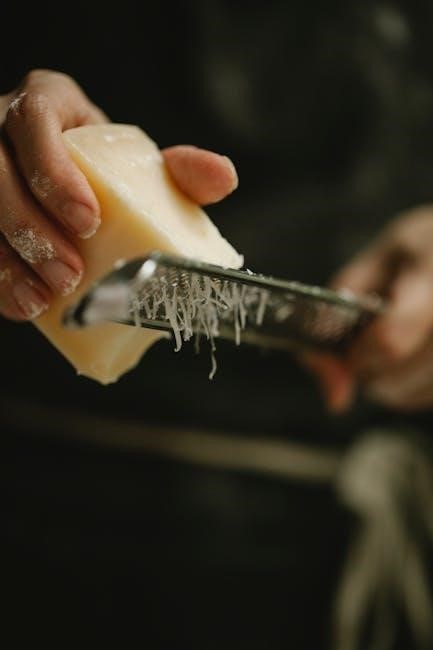cooks shank portion ham instructions
Cooking a ham shank is a delightful and flavorful experience‚ offering a perfect balance of savory and sweet notes. Whether glazed‚ roasted‚ or braised‚ this versatile cut delivers tender‚ juicy meat ideal for any occasion‚ from casual meals to festive gatherings.

Understanding the Cut
A ham shank‚ or shank portion‚ comes from the lower leg of the pig‚ offering rich‚ flavorful meat surrounding the femur bone. It is leaner than the butt portion and is available both cooked and uncooked for versatile preparation.
2.1 What is a Ham Shank?
A ham shank‚ also known as a shank portion‚ is a cut of pork taken from the lower leg of a pig‚ specifically above the hock. It includes part of the femur bone surrounded by flavorful‚ tender meat. Available both cooked and uncooked‚ fresh ham shanks require extended cooking to become tender‚ while pre-cooked versions can be reheated for convenience. Known for its rich‚ savory flavor‚ the ham shank is a popular choice for various dishes‚ from glazed hams to hearty stews. Its leaner profile compared to other cuts makes it a versatile option for both casual meals and special occasions. When cooked properly‚ the meat becomes juicy and falls easily off the bone‚ offering a satisfying dining experience. Whether roasted‚ braised‚ or boiled‚ the ham shank delivers a delicious‚ comforting meal that can be enjoyed in many ways‚ making it a favorite among home cooks and professional chefs alike.
2.2 Types of Ham Cuts
Ham cuts vary based on the pig’s anatomy and curing methods‚ offering diverse textures and flavors. The shank‚ from the lower leg‚ is leaner and often used for cooking. The butt portion‚ from the upper leg‚ is fattier‚ yielding a softer texture. Spiral-cut hams are pre-sliced for convenience‚ while bone-in and boneless options cater to different preferences. City hams are smoked and brined‚ available in shank or butt portions‚ while country hams are salt-cured and dried‚ requiring rehydration before cooking. Picnic hams‚ from the shoulder‚ are less cured and often sold fresh. Each cut suits specific recipes‚ from glazed roasts to hearty stews‚ ensuring there’s a ham option for every taste and occasion.
Benefits of Cooking a Ham Shank
Cooking a ham shank offers numerous benefits‚ making it a popular choice for home cooks and professional chefs alike. The shank is a flavorful and juicy cut‚ ideal for achieving tender meat when cooked low and slow. Baking or braising a ham shank ensures even distribution of moisture‚ resulting in a deliciously savory dish. It’s also a cost-effective option‚ providing ample servings for large gatherings or leftovers for future meals. The versatility of the ham shank allows for various cooking methods‚ such as glazing‚ roasting‚ or slow-cooking‚ each delivering unique flavor profiles. Additionally‚ a ham shank is easier to handle and carve compared to larger whole hams‚ making it a practical choice for both everyday meals and special occasions. Whether you’re aiming for a festive centerpiece or a hearty‚ comforting meal‚ a ham shank is a reliable and satisfying option that never disappoints.

Choosing the Right Ham Shank or Butt Portion
Selecting the right ham shank or butt portion is crucial for achieving the best results in your recipe. The ham shank‚ taken from the lower leg of the pig‚ is typically leaner and offers a robust‚ meaty flavor. In contrast‚ the butt portion‚ from the upper section‚ is fattier‚ which enhances tenderness and richness during cooking. Both cuts are available in fresh or pre-cooked forms‚ with the latter requiring only reheating. When purchasing‚ opt for a bone-in cut‚ as the bone adds depth to the flavor. For a smoked variety‚ look for one that’s been cured in a saltwater brine‚ ensuring a juicy‚ savory taste. If you prefer a raw ham‚ ensure it’s labeled as such to avoid confusion with pre-cooked options. The size of the ham shank or butt portion should accommodate your guest count‚ typically ranging between 8-10 pounds. Choosing the right cut sets the foundation for a flavorful and memorable dish‚ whether you’re glazing‚ roasting‚ or slow-cooking it.

Essential Ingredients for the Recipe
Preparing a delicious ham shank requires a few key ingredients to ensure flavor and moisture. Start with a bone-in ham shank or butt portion‚ weighing between 8-10 pounds. Water is added to the roasting pan to keep the meat moist during cooking; For the glaze‚ light brown sugar and Dijon mustard are essential‚ providing a sweet and tangy base. Optional whole mustard seeds can be added for texture. Additional ingredients like black pepper and bay leaves enhance the seasoning. If desired‚ a splash of bourbon or spices like cinnamon or cloves can add depth to the glaze. These ingredients work together to create a balanced‚ savory-sweet flavor profile that complements the natural richness of the ham shank. Keeping the ingredient list simple ensures ease of preparation while delivering a mouthwatering result for any occasion.
Step-by-Step Cooking Instructions
- Preheat the oven to 325°F (165°C). Trim any excess fat from the ham shank and place it in a roasting pan;
- Add 1 cup of water to the bottom of the pan to maintain moisture and cover tightly with aluminum foil.
- Bake for 2 hours‚ ensuring the meat stays tender and juicy. While cooking‚ prepare the glaze by mixing brown sugar and Dijon mustard in a bowl.
- Remove the ham from the oven 30 minutes before cooking time is up. Take off the foil and spread the glaze evenly over the ham‚ covering all surfaces.
- Return the ham to the oven‚ uncovered‚ for the remaining 30 minutes to allow the glaze to set and caramelize.
- Once done‚ let the ham rest for 10-15 minutes before carving. For a decorative touch‚ add whole mustard seeds to the reserved glaze and serve on the side.
This method ensures a perfectly glazed‚ flavorful ham shank that’s moist and full of character‚ ideal for any gathering or special occasion.
Glaze Preparation and Application
Preparing a delicious glaze is a key step in enhancing the flavor of your ham shank. Start by combining 1 cup of brown sugar and 1/4 cup of Dijon mustard in a small bowl. Mix well until smooth and free of lumps. For added texture‚ stir in 2 teaspoons of whole mustard seeds‚ which provide a subtle tang and visual appeal.
About 30 minutes before the ham is done cooking‚ carefully remove it from the oven and brush the glaze evenly over the surface‚ ensuring all sides are coated. Return the ham to the oven‚ uncovered‚ to allow the glaze to set and caramelize for the remaining 30 minutes of cooking.
For an extra touch‚ reserve a portion of the glaze and heat it in short bursts in the microwave until warm and syrupy. Serve this alongside the carved ham for an additional drizzle of flavor. This step ensures a perfectly glazed‚ moist‚ and flavorful ham shank that’s sure to impress your guests.

Tips for Achieving the Best Results
To ensure your ham shank turns out tender‚ flavorful‚ and visually appealing‚ follow these expert tips:
- Trim excess fat before cooking to prevent sogginess and promote even browning.
- Score the fat layer in a crisscross pattern to allow the glaze to penetrate deeper.
- Use a meat thermometer to ensure the internal temperature reaches 140°F for optimal tenderness.
- Tent the ham with foil during the resting period to retain moisture and heat.
- For slicing‚ let the ham rest for 10-15 minutes‚ then carve thinly against the grain for even portions.
- Reheat leftovers gently in a low-temperature oven to avoid drying out the meat.
- Experiment with glaze variations‚ such as adding spices or bourbon‚ for a unique twist.
- Reserve fat trimmings to render for cooking other dishes‚ adding a smoky flavor.
By following these tips‚ you’ll achieve a perfectly cooked‚ juicy ham shank with a rich‚ caramelized glaze that impresses every time.
Serving Suggestions and Leftover Ideas
A perfectly cooked ham shank is versatile and can be served in various ways‚ making it a crowd-pleaser for any occasion. Slice the ham thinly and serve it alongside classic sides like scalloped potatoes‚ green beans‚ or roasted vegetables for a hearty meal. It’s also a great addition to breakfast dishes‚ such as eggs Benedict or breakfast scrambles.
For leftovers‚ consider using the ham in sandwiches‚ wraps‚ or salads for a quick‚ flavorful meal. You can also shred the meat and add it to bean soups‚ pastas‚ or casseroles for extra protein and texture. Another idea is to dice the ham and mix it into potato salad or stuffing for added richness.
Leftover ham can be stored in the refrigerator for up to a week or frozen for several months. Reheat slices in the oven at 325°F‚ wrapped in foil‚ to retain moisture. This dish is not only delicious fresh but also offers endless possibilities for creative reuse‚ ensuring no part of the ham goes to waste.
Variations and Substitutions
Elevate your ham shank recipe with creative variations and substitutions to suit your taste preferences. For a spicy kick‚ replace Dijon mustard with spicy brown mustard and add a splash of bourbon for a smoky twist. Alternatively‚ create a spiced glaze by mixing in cinnamon‚ cloves‚ or other warm spices.
Swap brown sugar for honey or maple syrup in the glaze for a different sweetness profile. For texture‚ substitute whole mustard seeds with poppy seeds or chopped fresh herbs like parsley or thyme. If ham shank isn’t available‚ try using pork shoulder or pork butt‚ though cooking times may vary slightly.
Experiment with international flavors by braising the ham in beer or wine‚ or try a Thai-inspired version with soy sauce and ginger. For a smoky touch‚ add liquid smoke to the glaze. These variations allow you to personalize the dish while maintaining its rich‚ savory appeal.
Cooking a ham shank is a rewarding process that yields tender‚ flavorful results perfect for any occasion. Whether you choose a classic glazed approach or experiment with creative variations‚ this versatile cut offers endless possibilities. With its rich‚ savory flavor and juicy texture‚ a well-cooked ham shank is sure to impress family and friends alike. Don’t hesitate to get creative with spices‚ glazes‚ and serving styles to make the dish truly your own. Remember‚ the key to success lies in proper preparation and patience‚ allowing the ham to absorb all the delicious flavors you add. Enjoy experimenting and savoring the delightful outcome of your culinary efforts!